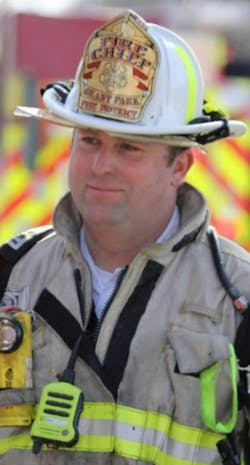Firefighter Training Strategies: A Comprehensive Approach to Increase Performance
Investing in training and development programs is a strategic decision that can empower individuals and organizations to reach their full potential. However, the effectiveness of a training program often depends on more than just the training content. To increase performance, individuals and organizations must adopt a proactive and holistic approach. Whether individuals want to enhance their skills or organizations seek to upskill their training program, there are easily identifiable tactics for achieving meaningful, long-lasting results. Far too often, training officers and instructors become complacent in their delivery and tend to forget two important factors: back to the basics and skill retention.
Size-up
Just as members size up every incident to which they respond, those who are in charge of training programs must size up training sessions. This process encompasses both the qualitative and quantitative methods of review to increase performance. Sizing up a training program gives a training officer the ability to identify the strengths and weaknesses of the program, what’s working and areas for improvement.
One of the most important aspects to evaluate is an organization’s operational readiness and how its training program aligns with its readiness. Successful training officers evaluate how closely their schedule, objectives, lesson plan, and delivery relate to organizational needs and operational readiness. The most successful training programs deliver holistic results that are based on outcomes that are tied directly to the needs of the jurisdiction.
To fully understand the direct correlation between the operational readiness and success metrics, the history of the training program and the department must be understood. Similar to fire behavior and the B.A.G. method, it’s important to break down and understand the evolution phases of the training program. Identifying a training program’s past and present provides a better perspective to evaluate what’s successful and what has room for improvement and to develop a vision for the program in the future. Bringing all of this together drives successful outcomes and, ultimately, a safer environment for firefighters.
Getting MORE out of a training program
Understanding how to maximize a training program can be rather simple. Think of MORE, from the perspective of “Measuring Opportunities to increase Retention and Engagement.” Truly a loaded phrase, but it can be so impactful.
Measure. How is what the department’s training program is doing currently measured? What’s working and what has areas for improvement? How is the program meeting not only the minimum standards of the organization but also standards for recertification?
Now, how does one truly measure the areas of excellence and the areas that need improvement? Rather than approaching this subjectively, utilize the skill retention method to identify those strengths and weaknesses that result in a more effective and objective measurement.
Opportunities. Training opportunities? What are those? This question never should be asked in today’s fire service. Training opportunities are everywhere: courses, conferences, podcasts, online lectures, webinars, etc. In the size up of a training program, selecting a few basic areas really can bring it back down to a manageable task.
- What is the standard and how are new firefighters trained?
- What does after-academy look like for the department, and how are new firefighters objectively measured throughout that process?
- What types of advanced training, from the fireground to special teams, are provided for firefighters?
- What threats are being identified in the department’s jurisdiction that justify new and enhanced training opportunities for firefighters?
These are all great questions. Thorough measurement of a training program and identification of new opportunities collectively drive the success.
Also, never forget that every day is a training day, even outside of the department. Are firefighters, company officers and command officers being provided with information and resources to take full advantage of lectures, hands-on training, conferences and networking opportunities outside of the department’s training? Don’t live on an island that instills the falsehood of thinking that nothing can be learned elsewhere. All this does is result in negative outcomes.
Retention. Often, we talk about firefighter recruitment and retention from the perspective of employment retention. In this case, consider retention with the mindset of capturing the retention that’s particular to training.
Defining the “why” is the first step for successful training retention. If firefighters are engaged via a process of helping them to understand why something is being done, buy-in is achieved, and they come back for more.
Furthermore, no one likes to have things shoved down their throat. Work together as a team and instill leadership through defining the why for every person while also approaching it with an open mind and ear to hear their perspective.
Also in play here: One of the most difficult topics in the fire service always seems to be succession planning. Who would think that succession planning and training are intertwined? Consider a model in which all of the information is laid out and everyone is shown what it looks like to go through the process of preparing for a promotion or role change in the organization. If firefighters are to be retained, be transparent in succession planning and share the message, so everyone has the same opportunity.
Engagement. Engagement is crucial for a successful training program, because it directly influences knowledge retention and application. Participant interaction during evolutions and classroom sessions and while using diverse teaching methods affects the success of a program. Engagement comes from several areas, but the first is through leadership and mentorship. Leadership in a training program involves guiding, motivating and facilitating the learning journey, which can be accomplished through formal and informal leadership. If firefighters are approached informally—to encourage participation, address challenges, gain input, define the why and lead by example—not only is an environment of engagement fostered but so is a culture of continuous improvement.
Organizational culture and attitude play a significant role in the engagement within a training program. A positive and supportive culture encourages active participation and a willingness to learn and be involved. A process by which firefighters perceive training as an important part of organization values enhances motivation and engagement, which leads to more effective learning outcomes.
Skill retention
Consider this: It’s 3:00 a.m. The department is dispatched to a structure fire. As an instructor, training officer or chief officer, are you comfortable and certain that your firefighters will perform at the same level that they would at 9:00 a.m.? Are you comfortable with your answer to, “Why are we leading that line out for the third time? Didn’t we do it right the first two times?”
Skill retention is crucial, because it ensures that the knowledge and abilities that were acquired during a training program enhance over time, rather than the training just serving to check a box. Effective training programs incorporate strategies for reinforcement, such as ongoing practice, mentorship and real-world application. By leveraging skill retention, organizations can maximize the long-term effect of training, which enhances performance and contributes to overall organizational success.
As important as skill retention is for driving organizational success, it also serves to provide information so that opportunities to increase retention and engagement truly can be measured objectively. The data that skill sheets or job performance requirements provide collectively give the information that’s needed to make informed decisions about how to improve a training program.
Past, present, future
Investing in a training program is as important as anything else in an organization. Without the investment, including understanding how to improve the delivery and retention of training, each and every person in a department suffers.
Be strategic in an analysis of a program, and don’t be afraid to dive deep and look at where the training program has been, where it is and where it’s desired to be in the future. Rome wasn’t built in a day, nor can we expect a training program to be either.
About the Author

Matt Shronts
Matt Shronts is a 24-year veteran of the fire service. He is deputy fire chief of the South Chicago Heights, IL, Fire Department and is a senior solutions engineer at Vector Solutions, specializing in integrating technology to transform training and operations. Shronts obtained a master's degree in public safety administration from Southern Illinois University and is a credentialed Chief Fire Officer with the Center for Public Safety Excellence.
